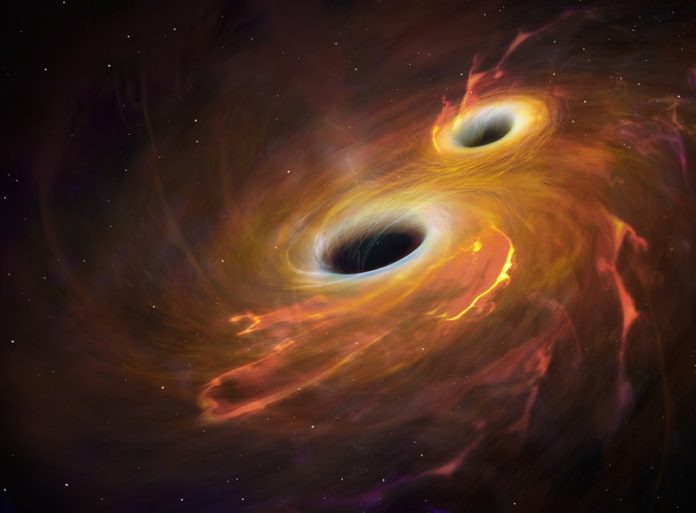Some 9 billion years ago, a pair of black holes — around 51 and 34 times the mass of the Sun — merged in a colossal collision.
They formed a new black hole around 80 times the mass of the Sun, and the ensuing blast in their final seconds sent gravitational waves coursing through space-time.
Travelling at the speed of light, those infinitesimally tiny ripples washed through Earth on July 29 last year.
And now, those gravitational waves — produced by the biggest black hole collision we’ve seen so far — have been uncovered, along with three others formed along similar (albeit less hefty) lines.
The four new discoveries, to be published in Physical Review X, take the tally of gravitational wave detections to 11.
Ten of the gravitational waves, including the first detection reported in 2016, were created by the merging of black holes, another came from colliding neutron stars.
Susan Scott, a physicist at the Australian National University and paper co-author, said the new discoveries are a “big advancement”.
“Four more is a big percentage,” Professor Scott said.
“And now we’ve got a lot more information coming in about these binary black hole systems.”
Unlike previous gravitational wave discoveries, which were detected as they happened, these four were found by refining existing data and teasing the gravitational wave signature from the noise.
“In other words, the new events we’re now announcing were actually in the can, so to speak,” Professor Scott said, “but we hadn’t unearthed them in the original, real-time analyses we performed.”
Why more gravitational waves are needed
While not as far away or huge as the event detected on July 29, the binary black hole mergers that produced the other three gravitational waves were not to be sneezed at.
They took place between 3 and 6 billion light-years away, and ended up with black holes around 56 to 66 times the Sun’s mass.
The gravitational waves were detected by the LIGO observatories 3,000 kilometres apart in Livingston, Louisiana and Hanford, Washington in the US.
Each instrument uses laser beams to constantly measure the length of two perpendicular 4-kilometre pipes with exquisite precision.
Any tiny, fleeting changes in length can reveal a passing gravitational wave.
The four newest gravitational wave discoveries were detected in data collected towards the end of LIGO’s second observation period of November 30, 2016 to August 25, 2017.
On August 1, 2017 the Italian Virgo gravitational wave detector joined in.
Physicists combined Virgo data with LIGO’s observations to precisely calculate where in the sky one of the sources came from.
Records aside, every new detection can give physicists valuable information about how binary black holes form.
For instance, there are some mass ranges where there are no black holes.
“One ‘mass gap’ is at the lower end, between the masses of what we know to be neutron stars and about five solar masses,” Professor Scott said.
“But then there’s another mass gap higher up the scale as well.”
Binary black holes so far detected by their gravitational waves seem to fit in around these mass gaps.
And as physicists find more gravitational waves, “we’ll be able to pin down the mass spectrum for these black holes”, she added.
Precisely how black holes end up in these binary systems, too, is a bit of a mystery.
One way starts with a pair of stars twirling around each other that, in time, evolve and collapse to become two black holes that spin on aligned axes.
“Or it could be in a very dynamic environment, like in a cluster with lots of different things,” Professor Scott said.
“In that case you’d expect the black holes’ spins might be in different directions, and not be aligned.”
And gravitational waves carry the signature of the black holes’ spin.
“By getting statistics on the population, like their masses and their spin, we can begin to formulate how these binaries formed in the first place and how they get together,” Professor Scott said.
“These types of processes underpin the whole evolution of the universe, in a sense.”
Physicists won’t have to wait too much longer for more gravitational wave detections to roll in.
LIGO and Virgo are currently offline, but their next observing run, with upgraded and more sensitive instruments, begins early in 2019.








